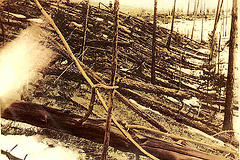
Somebody up there hates Siberia.
On June 30, 1908, something huge exploded over the Tunguska River near modern Evenkia. The blast felled 60 million trees over 2,150 square kilometers; it’s been estimated at between 10 and 15 megatons. Witnesses described a huge fireball moving across the sky, a flash, and a shockwave that knocked people off their feet and broke windows up to 400 miles away. Afterward, the night sky glowed for weeks.
But, strangely, there was no crater. In fact, a few trees near ground zero were still standing, their branches and bark stripped off. Stranger still, some reports said the skyglow had begun the night before the explosion, and that there had been strange weather and increased seismic activity for days beforehand. And carbon-14 dating of the soil gave a date in the future — meaning the soil had somehow become enriched with radioactive carbon-14.
What caused the explosion? A meteor? A comet? An asteroid? There’s been no conclusive explanation. But, disturbingly, a similar thing happened just three years ago. An explosion in Siberia in September 2002 that measured up to 5 kilotons was accompanied by northern lights, increased radioactivity, and an outbreak of unknown diseases nearby. An expedition the following year concluded that it was a comet, but no one knows for sure.
